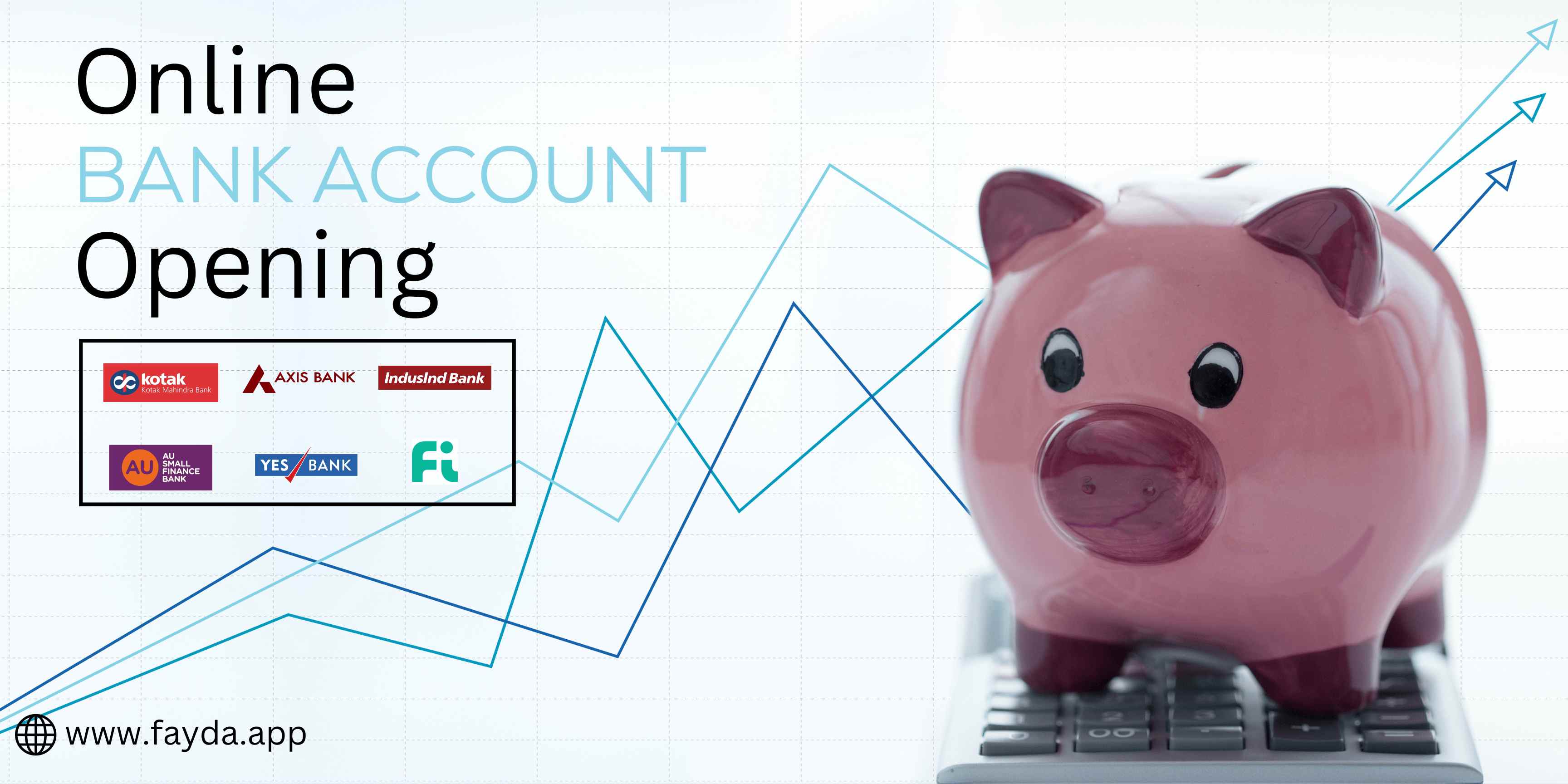Apr

How can I apply online for bank account
In today's digital era, applying for a bank account online has become a convenient and time-saving option for many individuals. With just a few clicks, you can complete the application process from the comfort of your own home or office, without the need to visit a bank branch in person. If you're considering opening a bank account online, this blog will provide you with a step-by-step guide on how to do it easily and securely.
Step 1: Choose the Bank and Account Type
The first step in applying online for a bank account is to choose the bank and the type of account that best meets your needs. Research different banks and compare their account options, features, fees, and customer reviews to make an informed decision. Consider factors such as the bank's reputation, accessibility of ATMs, online banking capabilities, and customer service.
Once you have chosen a bank, decide on the type of account you want to open. Common types of bank accounts include savings accounts, checking accounts, and money market accounts. Each account type has its own features and benefits, so choose the one that aligns with your financial goals and needs.
Step 2: Visit the Bank's Website
After selecting the bank and account type, visit the bank's official website. Ensure that the website is legitimate and secure by checking for a padlock icon in the URL bar, which indicates that the website is encrypted and safe to use. Avoid clicking on any suspicious links or providing personal information on unsecured websites to protect your privacy and security.
Step 3: Find the Online Account Application Form
On the bank's website, look for the option to open a new account or apply for an account online. This may be displayed prominently on the homepage or under a specific tab such as "Accounts," "Open an Account," or "Apply Now." Click on the link or button to access the online account application form.
Step 4: Fill Out the Application Form
The online account application form will require you to provide personal information such as your name, contact details, date of birth, Social Security number or taxpayer identification number, employment information, and other relevant details. Ensure that you fill out the form accurately and completely, as any errors or omissions may delay the application process.
You may also need to provide additional information depending on the type of account you are applying for. For example, if you are applying for a joint account, you will need to provide the co-applicant's information. If you are applying for a business account, you may need to provide your business's tax identification number, legal name, and other relevant details.
Step 5: Review and Submit Your Application
Once you have completed the online account application form, review all the information you have provided to ensure that it is accurate and complete. Double-check your personal details, contact information, and any other relevant information before submitting your application. Read and understand the terms and conditions of the account, including any fees, interest rates, and account disclosures.
If you are satisfied with the information provided, submit your application by clicking on the "Submit" or "Apply" button. Some banks may require you to provide an electronic signature or consent to a credit check as part of the application process.
Step 6: Provide Additional Documentation, if Required
After submitting your online account application, the bank may request additional documentation to verify your identity and address. This may include providing copies of your driver's license, passport, utility bills, or other documents as requested. Ensure that you provide the requested documents promptly to expedite the application process.
Step 7: Wait for Approval and Account Setup
Once the bank receives your application and verifies your information, they will review your application and notify you of the status of your account application. This may take a few days to a couple of weeks, depending on the bank's processing time and the type of account you are applying for.
If your application is approved, the bank will typically send you an email or a notification with instructions on how to set up your online banking access and how to fund your new account. Follow the instructions provided to activate your account and start using it for your banking needs.
Step 8: Fund Your Account
To start using your new bank account, you will need to fund it with an initial deposit. The bank will provide you with instructions on how to do this, which may include options such as transferring money from another bank account, depositing a check, or visiting a bank branch in person. Follow the instructions provided by the bank to successfully fund your account and ensure it is ready for use.
Step 9: Explore Online Banking Features
One of the advantages of opening a bank account online is the ability to access and manage your account through online banking. Once your account is set up and funded, take the time to explore the various features and services offered by the bank's online banking platform. This may include checking your account balance, transferring money between accounts, paying bills online, setting up automatic payments, and managing your account preferences.
Step 10: Review Account Statements and Monitor Your Account
As with any bank account, it's important to regularly review your account statements and monitor your account activity for any discrepancies or unauthorized transactions. Set up alerts and notifications through your online banking platform to receive updates on your account activity, and report any issues or concerns to the bank immediately.
In conclusion, applying online for a bank account is a convenient and efficient way to open a new bank account without the need to visit a bank branch in person. By following the steps outlined in this blog, you can easily and securely apply for a bank account online. Remember to choose a reputable bank, provide accurate and complete information on the application form, fund your account, and familiarize yourself with the online banking features offered by the bank. With a little effort, you can open a bank account online and start managing your finances conveniently from anywhere, anytime.
Types of bank account
Banks offer a wide range of account types to suit the different needs and preferences of their customers. Here are some common types of bank accounts:
- Savings Account: A savings account is designed for individuals or businesses to save money and earn interest on the deposited funds. Typically, savings accounts have limits on the number of transactions allowed per month and may require a minimum balance to be maintained to avoid fees.
- Current Account: A current account, also known as a checking account or a transactional account, is a type of bank account that is designed for frequent transactions, such as deposits, withdrawals, and payments. Current accounts are typically used for day-to-day financial activities, such as paying bills, making purchases, and managing everyday expenses.
- Money Market Account: A money market account is similar to a savings account, but usually offers higher interest rates and may have higher minimum balance requirements. Money market accounts often come with limited check-writing capabilities and may have transaction limits.
- Certificate of Deposit (CD): A CD is a time-bound deposit account that requires the account holder to leave the funds untouched for a specific period of time, known as the term. CDs typically offer higher interest rates than savings or checking accounts, but penalties may apply for early withdrawals.
- Individual Retirement Account (IRA): An IRA is a specialized account designed for retirement savings. There are different types of IRAs, such as Traditional IRAs and Roth IRAs, with varying tax benefits and contribution limits. IRAs are subject to certain withdrawal restrictions and penalties for early withdrawals.
- Business Accounts: Banks also offer various types of accounts for businesses, including business savings accounts, business checking accounts, and merchant services accounts. These accounts may have additional features tailored to the needs of businesses, such as higher transaction limits, payroll services, and business credit cards.
- Joint Accounts: Joint accounts are shared accounts that allow two or more individuals to open and manage an account together. Joint accounts can be used for various purposes, such as joint savings for a common goal or joint checking for shared expenses.
- Trust Accounts: Trust accounts are accounts managed on behalf of a trust, which is a legal arrangement where a person or entity holds and manages assets on behalf of another person or group. Trust accounts can have specific rules and restrictions based on the terms of the trust.
- Student Accounts: Many banks offer specialized accounts for students, typically with lower or no fees and features such as overdraft protection, online banking, and mobile banking. Student accounts are designed to cater to the unique financial needs of students, such as managing their expenses during their educational years.
- Specialty Accounts: Some banks also offer specialty accounts for specific purposes, such as foreign currency accounts, high net worth accounts, and charitable accounts, among others. These accounts may have unique features and requirements based on their intended purpose.
It's important to understand the different types of bank accounts and their features to choose the one that best fits your financial goals and needs. It's also advisable to review and compare the account terms, fees, and requirements of different banks before opening an account to make an informed decision.


